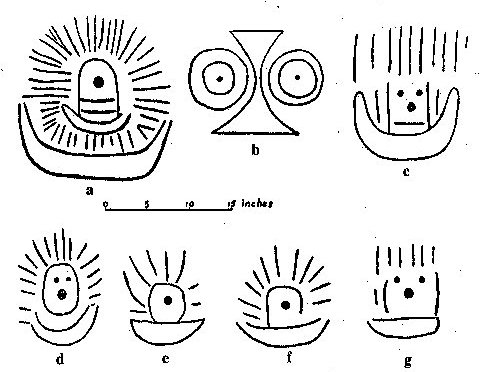|
TRANSLATIONS
This is the 5th period, the time of noon. The movement of the sun over the sky is no longer as fast as what it looks like when the sun in early morning is near the horizon, the time of dramatic changes is over. The sun is now like a fully grown person, that we can see in Pa5-47 and Pa5-48. The rays of the sun are in full power and illuminate everything, Pa5-49. Indeed, we might even realize that the beams of the ship of the sun (Pa5-50) can be understood to mean both those made of wood and those made of light. In Pa5-47 we see that the transformations has lead to a fully grown sun:
The central disc has gradually increased as a sign of the growth. At the time of birth (2nd period) he was like a chicken in the nest gaping for food, then he started to move and that quickly, like a fish (3rd and 4th periods). Stability has now been reached. The arm with its hand of fire, though, shows that there still is increase in power. Presumably this means that the 5th period ends at noon. Symmetry demands that the 5th period ends at noon, because in P there are 10 periods of light. We also notice that the arm now is tending towards vertical, a sign that the rays of the sun are nearly vertical. Indeed this is one of the origins of the vertical line as a mark for middle. Pa5-48 is the picture of a fully mature man, standing steady as the sun at summer solstice. His earplugs are sun symbols and his pointed head is formed like the top of a mountain of fire. His legs are assymmetric giving the picture of a walk towards us. The strings of kaikai are easily formed into this curious head: "The kaikai are the rythmic songs that are sung to cat's cradles, the string games that are found not only throughout the Pacific but throughout the world. On premissionary Rapa Nui the kaikai, together with their corresponding cat's cradles, were not simple children's games but were used, among other things, to produce magic effect. They were highly important for the study of Rapa Nui's rongorongo. This is because it was apparently with the aid of cat's cradles that the rongorongo experts taught their pupils to learn many of the chants accompanying the incised inscriptions." (Fischer)
"The late Amelia Tepano Ika was a beloved link with the past, a much sought-after teacher of the art of kaikai, string figures made and presented with accompanying chants." (Van Tilburg) Pa5-49 is a picture of light rays similar to those in the petroglyphs below .
(The petroglyphs are from the Society Islands according Heyerdahl) Pa5-50 is yet another tapa mea of the same kind as we have seen before, the marker that the text for the period ends here. |





